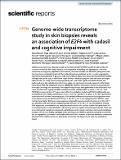Files in this item
Genome-wide transcriptome study in skin biopsies reveals an association of E2F4 with cadasil and cognitive impairment
Item metadata
| dc.contributor.author | Muiño, Elena | |
| dc.contributor.author | Maisterra, Olga | |
| dc.contributor.author | Jiménez-Balado, Joan | |
| dc.contributor.author | Cullell, Natalia | |
| dc.contributor.author | Carrera, Caty | |
| dc.contributor.author | Torres-Aguila, Nuria P. | |
| dc.contributor.author | Cárcel-Márquez, Jara | |
| dc.contributor.author | Gallego-Fabrega, Cristina | |
| dc.contributor.author | Lledós, Miquel | |
| dc.contributor.author | González-Sánchez, Jonathan | |
| dc.contributor.author | Olmos-Alpiste, Ferran | |
| dc.contributor.author | Espejo, Eva | |
| dc.contributor.author | March, Álvaro | |
| dc.contributor.author | Pujol, Ramón | |
| dc.contributor.author | Rodríguez-Campello, Ana | |
| dc.contributor.author | Romeral, Gemma | |
| dc.contributor.author | Krupinski, Jurek | |
| dc.contributor.author | Martí-Fàbregas, Joan | |
| dc.contributor.author | Montaner, Joan | |
| dc.contributor.author | Roquer, Jaume | |
| dc.contributor.author | Fernández-Cadenas, Israel | |
| dc.date.accessioned | 2021-04-16T08:30:13Z | |
| dc.date.available | 2021-04-16T08:30:13Z | |
| dc.date.issued | 2021-03-25 | |
| dc.identifier | 273791863 | |
| dc.identifier | dd920082-5c52-42dd-a1a0-dea47f5b127e | |
| dc.identifier | 85103407351 | |
| dc.identifier | 33767277 | |
| dc.identifier.citation | Muiño , E , Maisterra , O , Jiménez-Balado , J , Cullell , N , Carrera , C , Torres-Aguila , N P , Cárcel-Márquez , J , Gallego-Fabrega , C , Lledós , M , González-Sánchez , J , Olmos-Alpiste , F , Espejo , E , March , Á , Pujol , R , Rodríguez-Campello , A , Romeral , G , Krupinski , J , Martí-Fàbregas , J , Montaner , J , Roquer , J & Fernández-Cadenas , I 2021 , ' Genome-wide transcriptome study in skin biopsies reveals an association of E2F4 with cadasil and cognitive impairment ' , Scientific Reports , vol. 11 , 6846 . https://doi.org/10.1038/s41598-021-86349-1 | en |
| dc.identifier.issn | 2045-2322 | |
| dc.identifier.other | ORCID: /0000-0002-9502-9310/work/92372176 | |
| dc.identifier.uri | https://hdl.handle.net/10023/23040 | |
| dc.description | Funding: This work was supported by a grant from the Carlos III Health Institute (PI 11/0176), Generación Project, Maestro Project, INVICTUS+network, Epigenesis Project (Marató de TV3), FEDER funds and economic donations from “Asociación CADASIL España”. E. Muiño is supported by a Río Hortega Contract (CM18/00198) from the Carlos III Health Institute. J. Cárcel-Márquez is supported by an AGAUR Contract (agència de gestió d’ajuts universitaris i de recerca; FI_DGR 2019, grant number 2019_FI_B 00853) co-financed with Fons Social Europeu (FSE). M. Lledós is supported by a PFIS Contract (Contratos Predoctorales de Formación en Investigación en Salud) from the Carlos III Health Institute. | en |
| dc.description.abstract | CADASIL is a small vessel disease caused by mutations in NOTCH3 that lead to an odd number of cysteines in the EGF-like repeat domain, causing protein misfolding and aggregation. The main symptoms are migraine, psychiatric disturbances, recurrent strokes and dementia, being executive function characteristically impaired. The molecular pathways altered by this receptor aggregation need to be studied further. A genome-wide transcriptome study (four cases paired with three healthy siblings) was carried out, in addition to a qRT-PCR for validation purposes (ten new cases and eight new controls). To study the expression profile by cell type of the significant mRNAs found, we performed an in situ hybridization (ISH) (nine cases and eight controls) and a research in the Single-nuclei Brain RNA-seq expression browser (SNBREB). Pathway analysis enrichment was carried out with Gene Ontology and Reactome. Neuropsychological tests were performed in five of the qRT-PCR cases. The two most significant differentially expressed mRNAs (BANP, p-value = 7.23 × 10–4 and PDCD6IP, p-value = 8.36 × 10–4) were selected for the validation study by qRT-PCR. Additionally, we selected two more mRNAs (CAMK2G, p-value = 4.52 × 10–3 and E2F4, p-value = 4.77 × 10–3) due to their association with ischemic neuronal death. E2F4 showed differential expression in the genome-wide transcriptome study and in the qRT-PCR (p = 1.23 × 10–3), and it was upregulated in CADASIL cases. Furthermore, higher E2F4 expression was associated with worse executive function (p = 2.04 × 10–2) and attention and information processing speed (IPS) (p = 8.73 × 10–2). In situ hibridization showed E2F4 expression in endothelial and vascular smooth vessel cells. In silico studies indicated that E2F4 is also expressed in brain endothelial cells. Among the most significant pathways analyzed, there was an enrichment of vascular development, cell adhesion and vesicular machinery terms and autophagy process. E2F4 is more highly expressed in the skin biopsy of CADASIL patients compared to controls, and its expression is present in endothelial cells and VSMCs. Further studies are needed to understand whether E2F4 could be useful as a biomarker, to monitor the disease or be used as a therapeutic target. | |
| dc.format.extent | 12 | |
| dc.format.extent | 1264611 | |
| dc.language.iso | eng | |
| dc.relation.ispartof | Scientific Reports | en |
| dc.subject | QH301 Biology | en |
| dc.subject | QH426 Genetics | en |
| dc.subject | RC0321 Neuroscience. Biological psychiatry. Neuropsychiatry | en |
| dc.subject | NDAS | en |
| dc.subject.lcc | QH301 | en |
| dc.subject.lcc | QH426 | en |
| dc.subject.lcc | RC0321 | en |
| dc.title | Genome-wide transcriptome study in skin biopsies reveals an association of E2F4 with cadasil and cognitive impairment | en |
| dc.type | Journal article | en |
| dc.contributor.institution | University of St Andrews. School of Biology | en |
| dc.identifier.doi | https://doi.org/10.1038/s41598-021-86349-1 | |
| dc.description.status | Peer reviewed | en |
This item appears in the following Collection(s)
Items in the St Andrews Research Repository are protected by copyright, with all rights reserved, unless otherwise indicated.

